Living and Extinct Prehistoric Animals: Examples and Characteristics
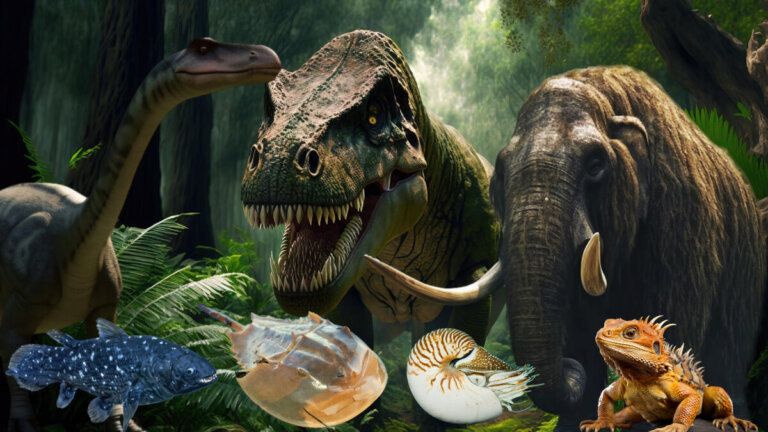

Written and verified by the biologist Georgelin Espinoza Medina
Life on planet Earth began a long time ago. Although the exact date is unknown, the first fossils date back more than 3 billion years. Since that time, there have been many changes at the biological level, with extinct life forms and other lineages that still remain in time. Do you want to learn about some prehistoric animals?
When you hear the words “prehistoric animals”, dinosaurs are probably the first to come to mind, as they’re the most well-known example and even the protagonists of major film productions. Other well-known prehistoric animals are mammoths and saber-toothed dinosaurs. However, there are more impressive specimens that are well worth discovering. Let’s take a look at 20 specimens in the following list along with their main characteristics.
What are prehistoric animals?
Before we begin our tour of the prehistoric world, let’s clarify a bit what organisms we’re referring to. In this case, we’re talking about the animals that existed on the planet before historic recordings, that is, before the invention of writing.
Some coexisted with the first hominids and others didn’t share their habitat with man.
Today, many of these creatures are extinct. However, certain lineages with a greater capacity for adaptation and survival persist today, perhaps not in the exact form of antiquity but with few changes in their appearance.
Extinct prehistoric animals
Most of the animals that have ever existed are now extinct from the planet forever. The causes are diverse, including climatic conditions, competition for resources, and major catastrophes such as volcanic eruptions and asteroid impacts, among others. Below are some specimens and their characteristics.
1. Saber-toothed tiger (Smilodon)
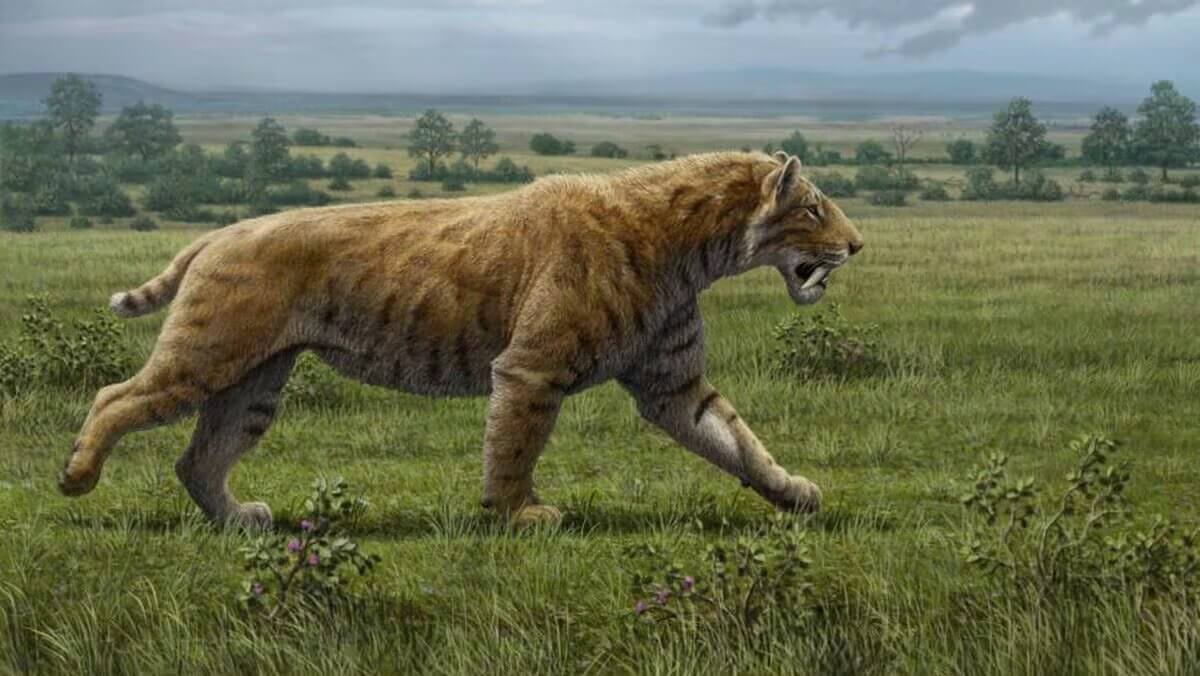
One of the most popular prehistoric animals is the saber-toothed tiger, with its long tusks up to 10 inches long. It was approximately 3.75 feet tall. It also had short but strong legs, which were useful for hunting large prey.
In fact, there were three species of them, included in the genus Smilodon:
- S. gracilis: the smallest of the three, reaching up to 220 pounds in weight.
- S. fatalis: of intermediate size, similar to a Siberian tiger, with a mass of up to 615 pounds.
- S. populator: the largest, weighing between 485 and 800 pounds (larger than any feline today).
The saber-toothed tiger was a skilled hunter, biting its prey in the neck to cut important arteries and produce a quick death.
Its disappearance from the planet is thought to have been caused by climate change and the extinction of its prey. Because its diet was so specialized in large mammals, it was unable to adapt to smaller ones.
2. Woolly mammoth (Mammuthus primigenius)
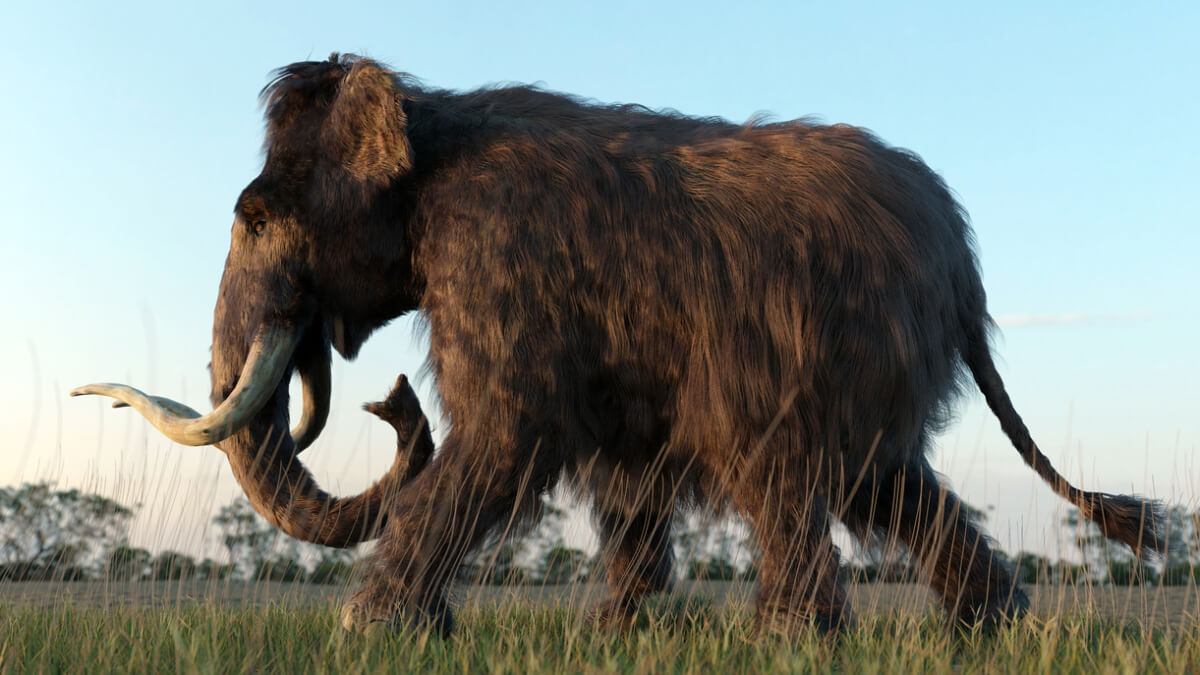
Also called woolly elephant or tundra mammoth. It owes its name to its very thick and long coat of hair that covered its body. This hair was brownish in color, lighter on the inner part and darker on the outer mantle. In addition to this protective covering, it had skin that was up to 3 inches thick: A true thermal insulator.
The woolly mammoth also stands out for its large size and its peculiar tusks. It was between 10 and 12 feet tall and weighed between 6 and 8 tons. Global warming after the last ice age caused the loss of its habitat and its extinction.
3. Spiny dogfish (Acanthodii)
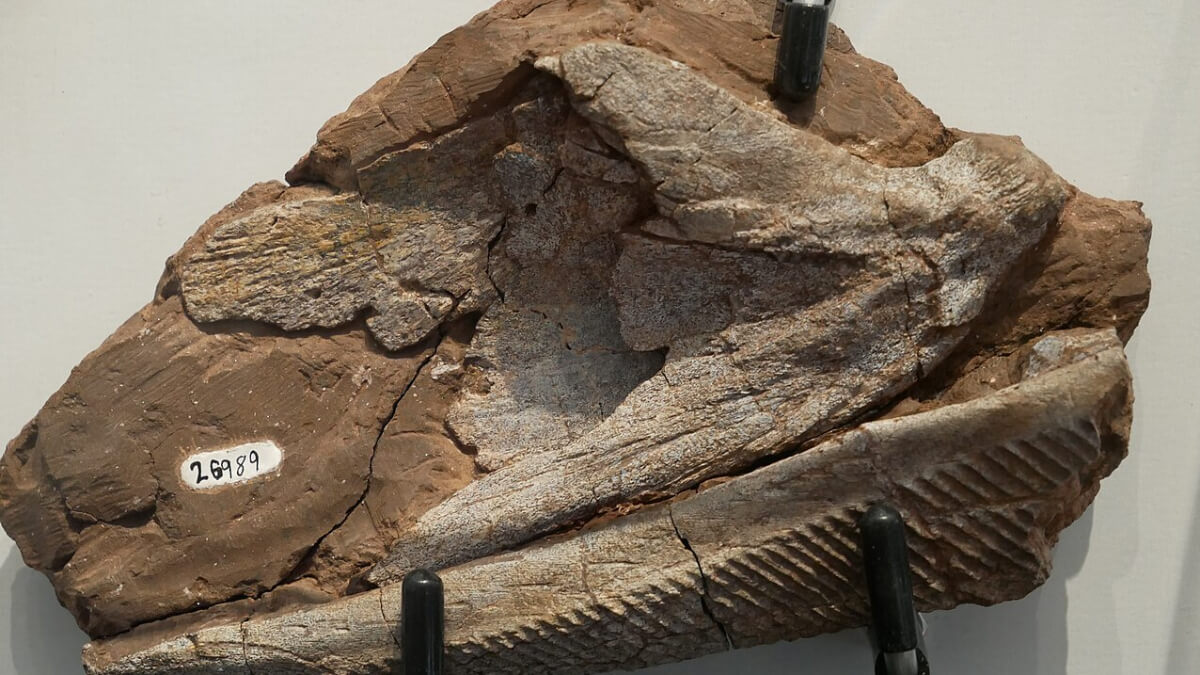
Spiny dogfish were small fish less than 10 inches in length, although some specimens, such as Gyracanthus, reached a size of approximately 6.5 feet. Some species lacked teeth, suggesting filter feeding, but others lived a predatory life.
They lived from the Silurian period to the Permian, when they became extinct. Moreover, this group is the subject of great debate, as some experts consider them the first bony fishes, while others point out that they’re more closely related to the first cartilaginous fishes.
They’re named for the presence of a large spine in front of each of their fins.
4. Tyrannosaurus (Tyrannosaurus rex)
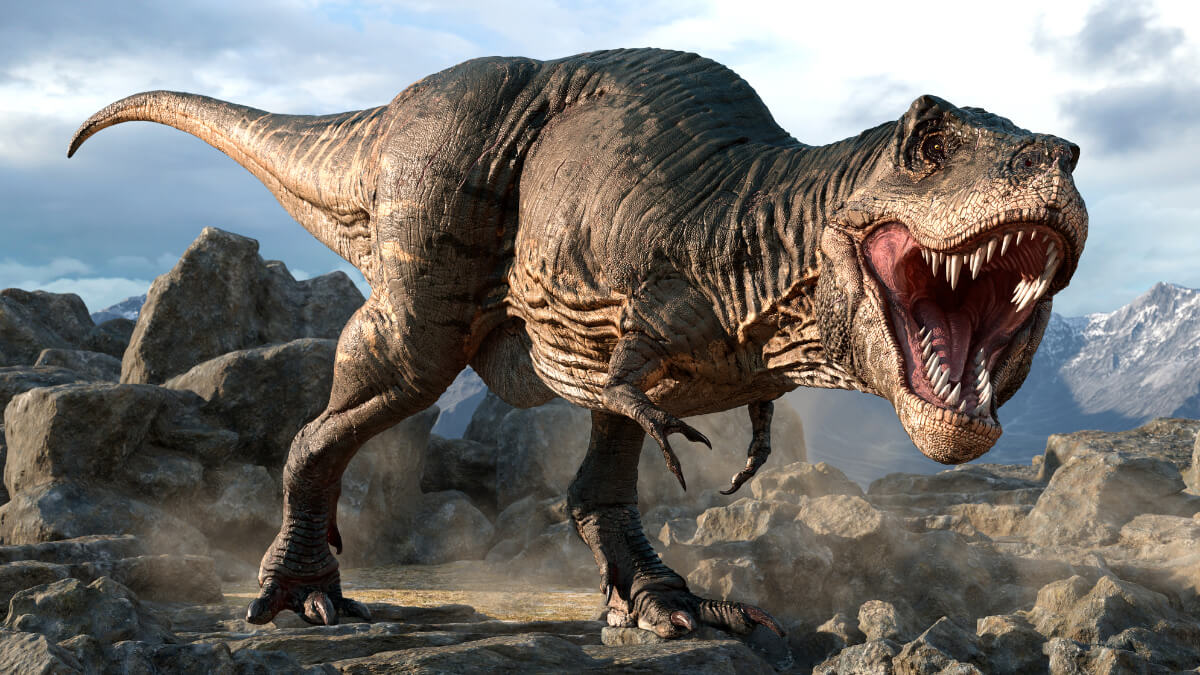
One of the most well-known prehistoric animals is the famous T-rex or Tyrannosaurus rex, which inhabited North America 65 million years ago. Among its characteristics are the following:
- Long and muscular tail.
- Large size (about 39 feet long).
- Well-developed eyesight, sense of smell, hearing, and balance.
- Large skull (up to 5.3 feet), wide jaws, and teeth up to 6 inches long.
- Short neck, as well as arms and hands with double digits, and long and robust hind limbs.
There is much debate about its external appearance, as some scientists think it may have had feathers on its body. Another controversial aspect is its diet, whether it was a predator or also lived a scavenger life.
Also, we can’t fail to mention its great bite force, which is more powerful than that of the Nile crocodile. This specimen is one of the most famous dinosaurs in history.
5. Yutyrannus (Yutyrannus huali)
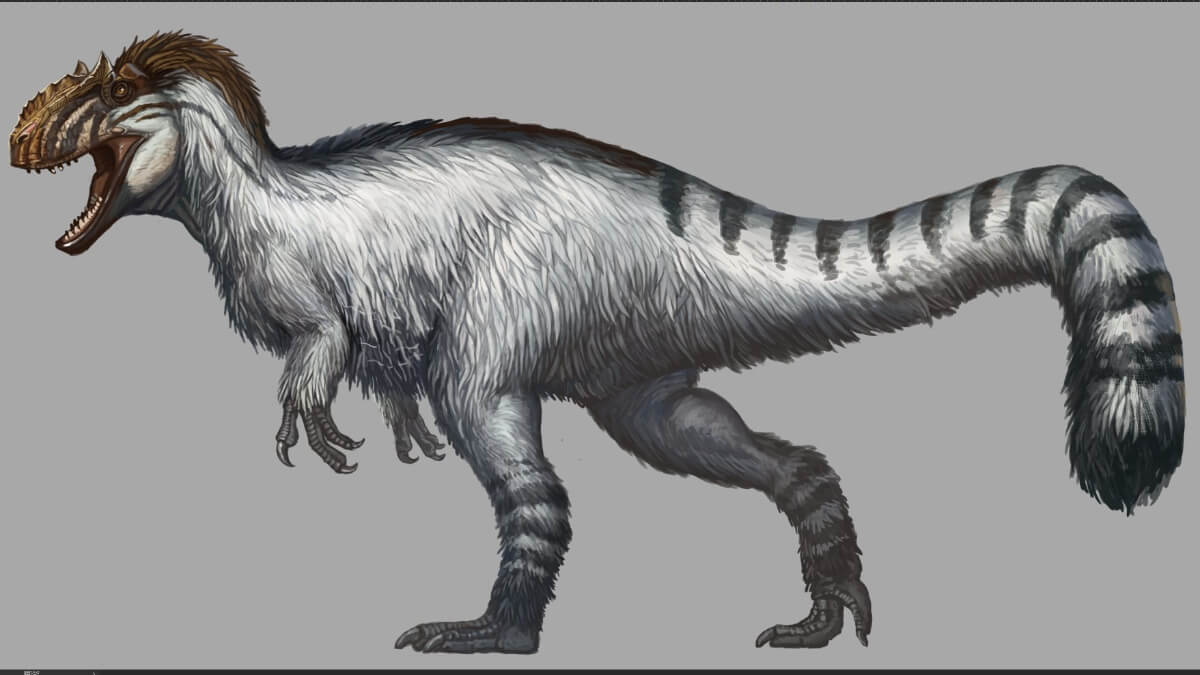
This is another large dinosaur and a relative of the tyrannosaurus. It’s known with certainty that it was a feathered animal. It inhabited Asia in the Cretaceous, in a cold forest environment.
The presence of feathers was very useful in regulating its body temperature.
It was almost 30 feet long and had a mass of 1.5 tons. Despite its long and filamentous feathers, its large size prevented it from flying; however, this covering was an important thermal insulation in its habitat.
6. Labocania (Labocania anomala)
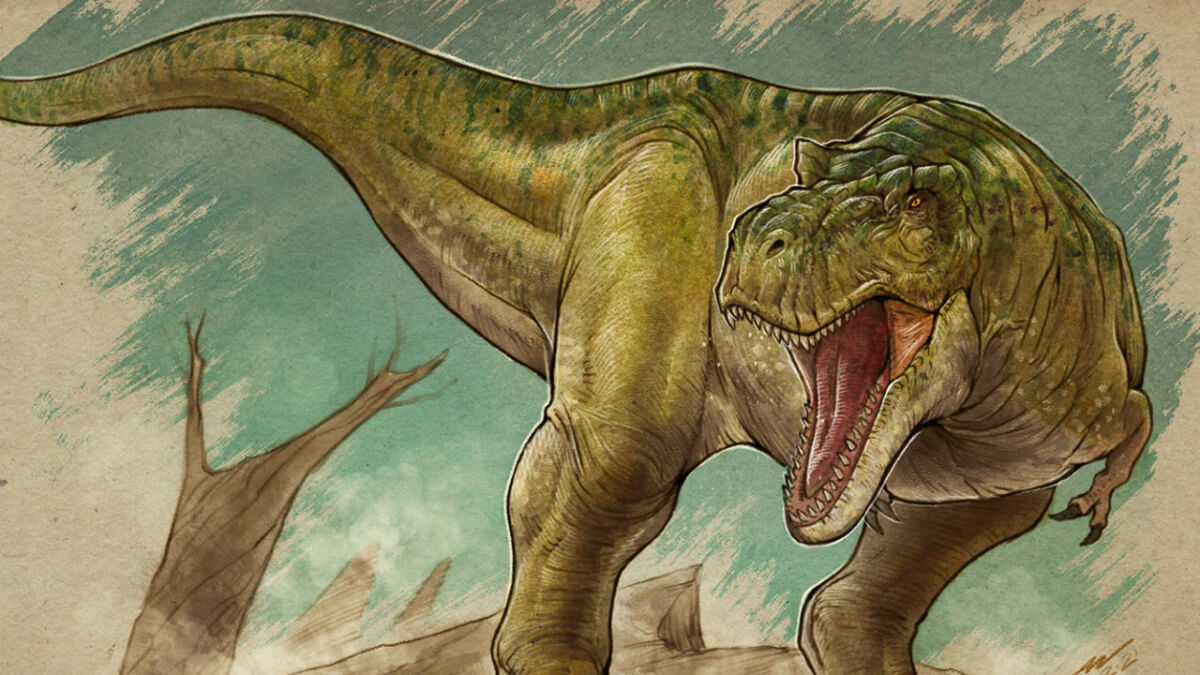
This is a carnivore found in the fossiliferous formation of La Bocana Roja in Baja California, which is the reason for its name Labocania. The epithet “anomala” refers to the combination of physical characteristics similar to tyrannosaurs and other types of dinosaurs.
Little is known about this carnivore, but it’s estimated to be about 26 feet long and weigh 1.5 tons. It lived in the Cretaceous, about 75 million years ago.
7. Argentinosaurus (Argentinosaurus huinculensis)
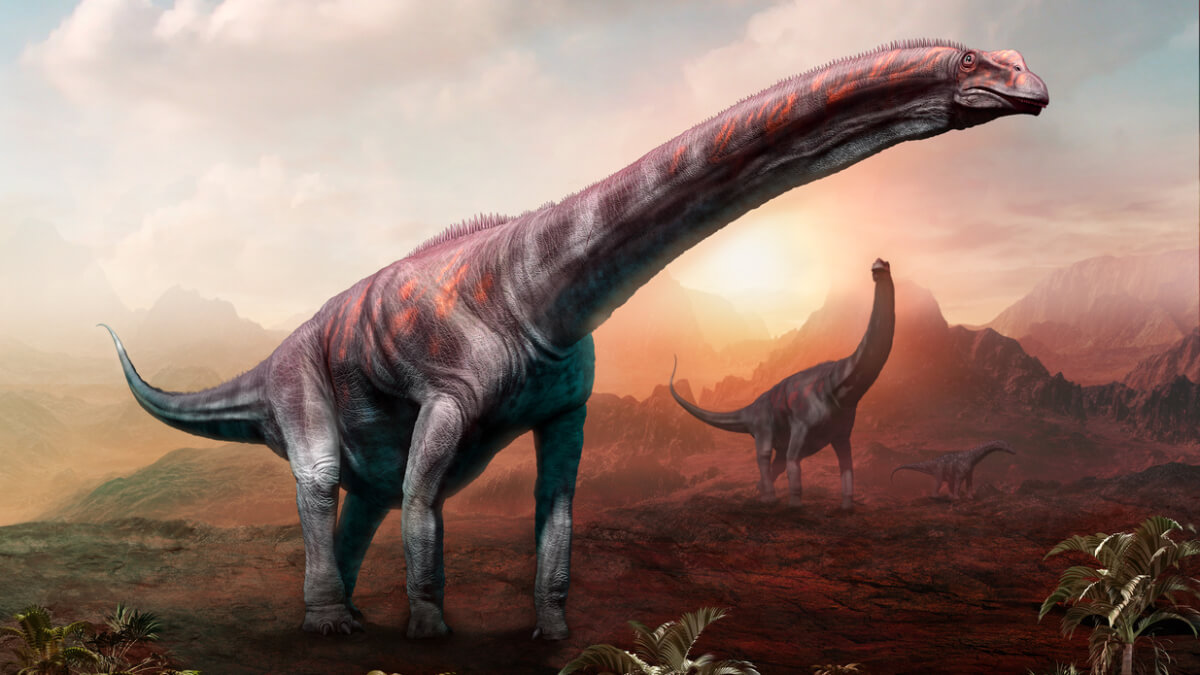
We continue mentioning dinosaurs in our list of extinct prehistoric animals. In this case, we have a herbivore, the Argentinosaurus. There’s controversy as to its size, due to the lack of evidence. However, it’s estimated that its body was around 98 to 130 feet long and weighed between 50 and 100 tons. For this reason, it’s considered one of the largest land animals that ever existed.
It had a long and robust neck, a small head, and a thick tail. Its teeth were adapted to cut the leaves of trees, as it didn’t chew its food. Its stomach was responsible for processing all the vegetation.
The neck of Argentinosaurus allowed it to have access to the available vegetation. Therefore, it could count on all the food it needed to satisfy its large size.
8. Pteranodon

In this case, we’re referring to a genus of strong flying reptiles that lived in the Late Cretaceous period. They had a wingspan of about 23 feet or more, although their bodies were somewhat small in comparison to the size of their wings.
One striking aspect of their appearance was the presence of a crest on the skull, which projected upwards on the back of the head. The male had it larger than the female. In addition, it had long, toothless jaws, which it’s believed to have used to feed on fish.
9. Ammonite (Ammonoids)
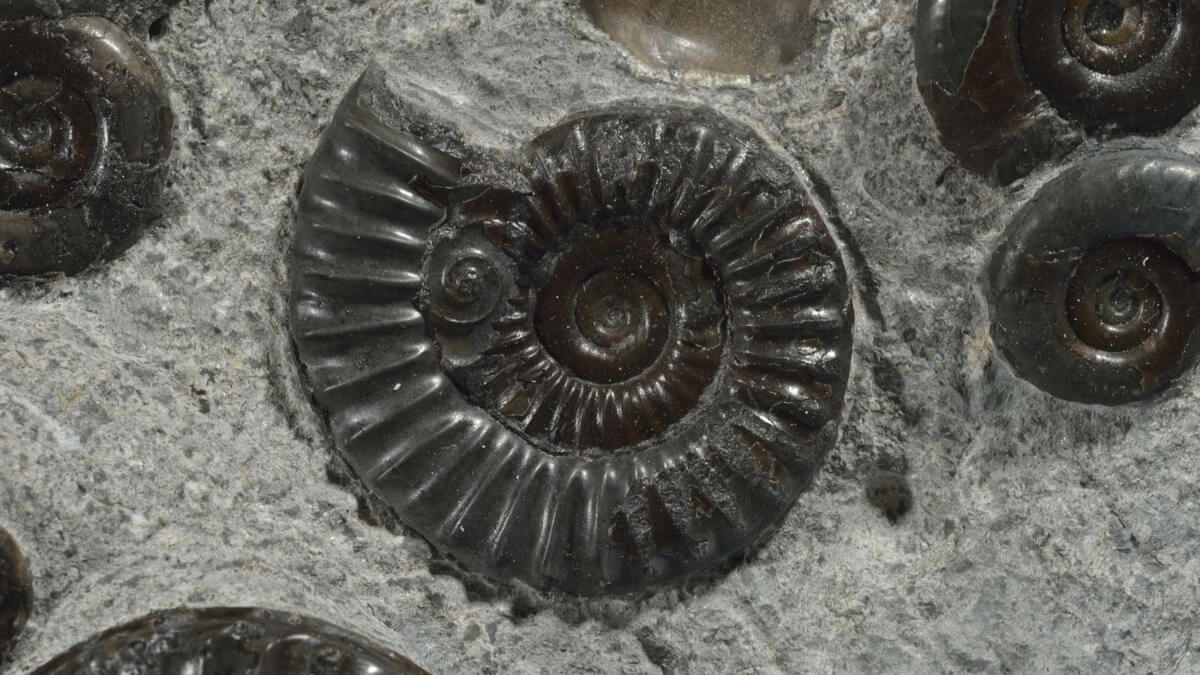
Among the prehistoric animals, we also find invertebrates, such as cephalopods known as ammonites. These populated the seas for a long period, at depths of no more than 985 feet.
The first representatives of the group appeared around 400 million years ago, while the last specimens became extinct 65 million years ago.
These soft-bodied animals had a conical shell that was rolled up to greater or lesser degrees and divided into chambers. Today, this shell is a record of their existence on the planet. Their body is a mystery, but it’s believed that they may have had about ten slender arms.
Another outstanding feature of their body was their beak, which was usually composed of chitin, as in other cephalopods. Their diet was variable and included the following species:
- Fish
- Bivalves
- Crustaceans
- Sea lilies
- Foraminifera
- Other ammonites
Ammonites were a very successful group, thanks to their high reproductive rates and small size at birth (just a few millimeters). Therefore, they were part of the marine plankton at this stage of their life, floating in the ocean at the mercy of the currents. This aspect allowed their worldwide distribution.
10. Nectocaris pteryx
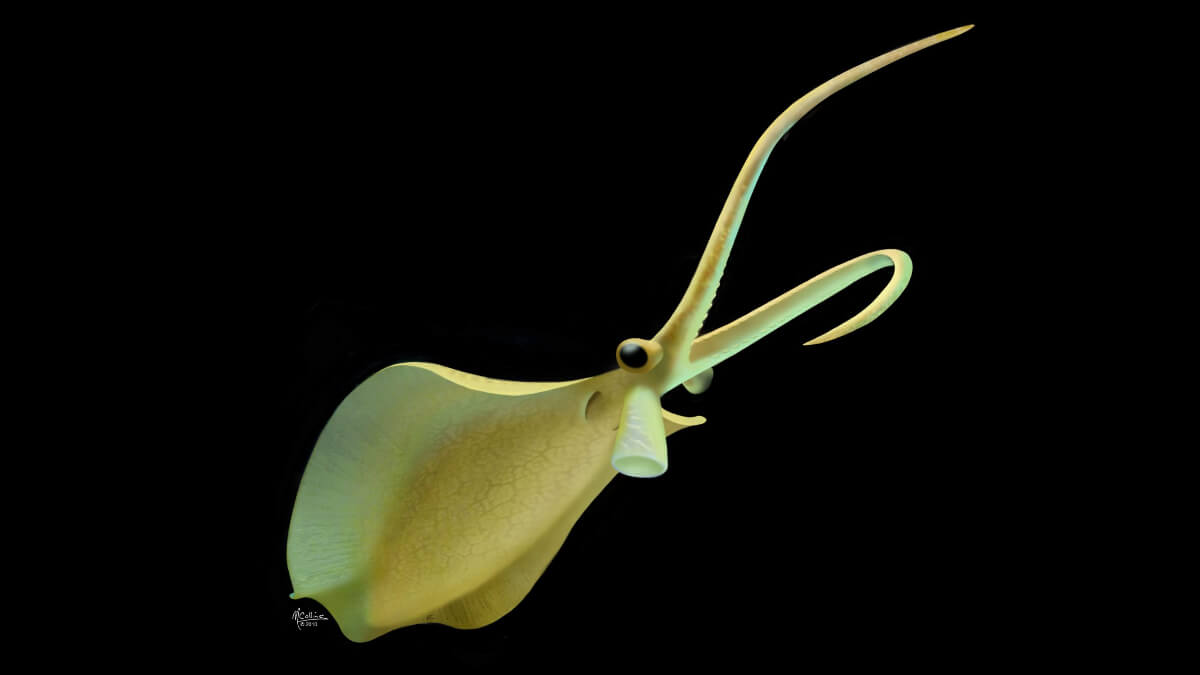
Here we have another cephalopod, which is considered the oldest because it dates back to about 500 million years ago, in the Cambrian period. The interesting thing about this animal was its small size, as it was only a few centimeters long. Its body was soft, flattened, and rhomboidal in shape. It lacked a shell and had a pair of long, prehensile tentacles.
El Nectocaris pteryx had a pair of wide lateral fins on its body, one on each side, and a siphon that served as a propeller. It also had a pair of eyes. It’s believed to have been a carnivore or scavenger.
11. Trilobite
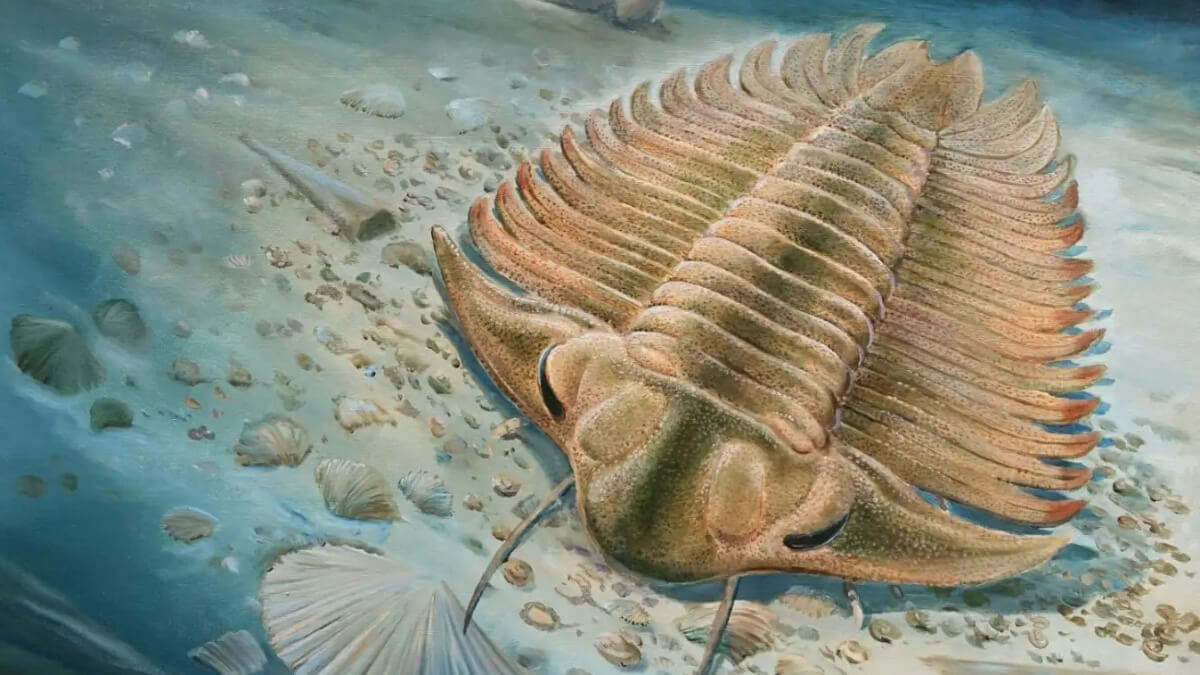
Now it’s time to talk about other invertebrates. Specifically, a group of marine and benthic arthropods, i.e., bottom-dwellers of the ocean floor. They appeared during the Cambrian period, and some species lived until the Permian. They had a variable size and a body with three lobes, a characteristic to which they owe their name.
They also had a segmented body divided into three regions: a cephalic section, the cephalon; an intermediate section, the thorax; and a posterior or caudal section, the pygidium. Each possessed a pair of articulated appendages. Some were blind, but others had eyes.
Trilobites had a chitinous exoskeleton, like any arthropod.
12. Yanliaomyzon lamprey (Yanliaomyzon occisor)
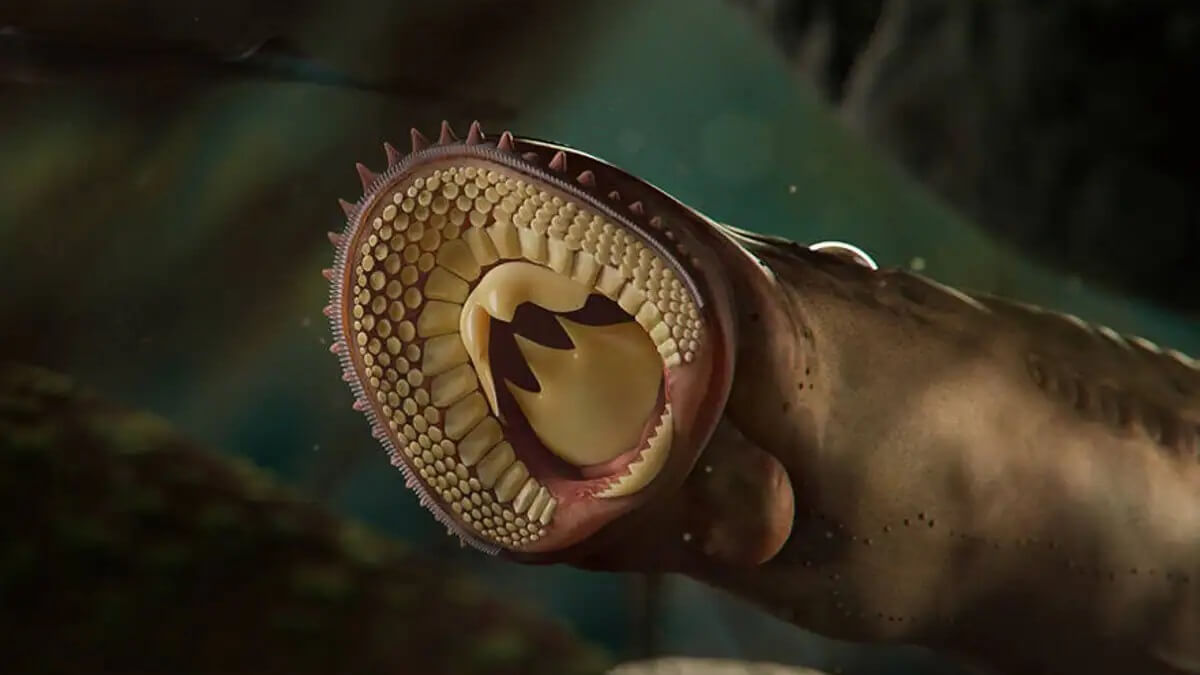
Sea lampreys are ancient animals that existed more than 360 million years ago. However, the species Yanliaomyzon occasion was found in rocks about 160 million years old in China. It possessed a staggering size of 25 inches, which positions it as the largest fossil lamprey yet found, as the more remote ones were smaller.
It had an oral sucker full of sharp teeth, which allowed it a carnivorous diet, and it fed on chunks of meat in bites. In addition, it’s believed to have been an active swimmer that went after its prey. This is detailed in a publication in the journal Nature Communications.
Occisor means killer, so the name refers to the specimen’s hunting ability.
Many species of lamprey are still alive today, and certain aspects of their morphology have been preserved over time. However, this feeding apparatus, similar to that of some modern species, differs from the original pattern of older specimens. Thanks to their discovery, more is known about their evolutionary development.
13. Megatherium (Megatherium americanum)
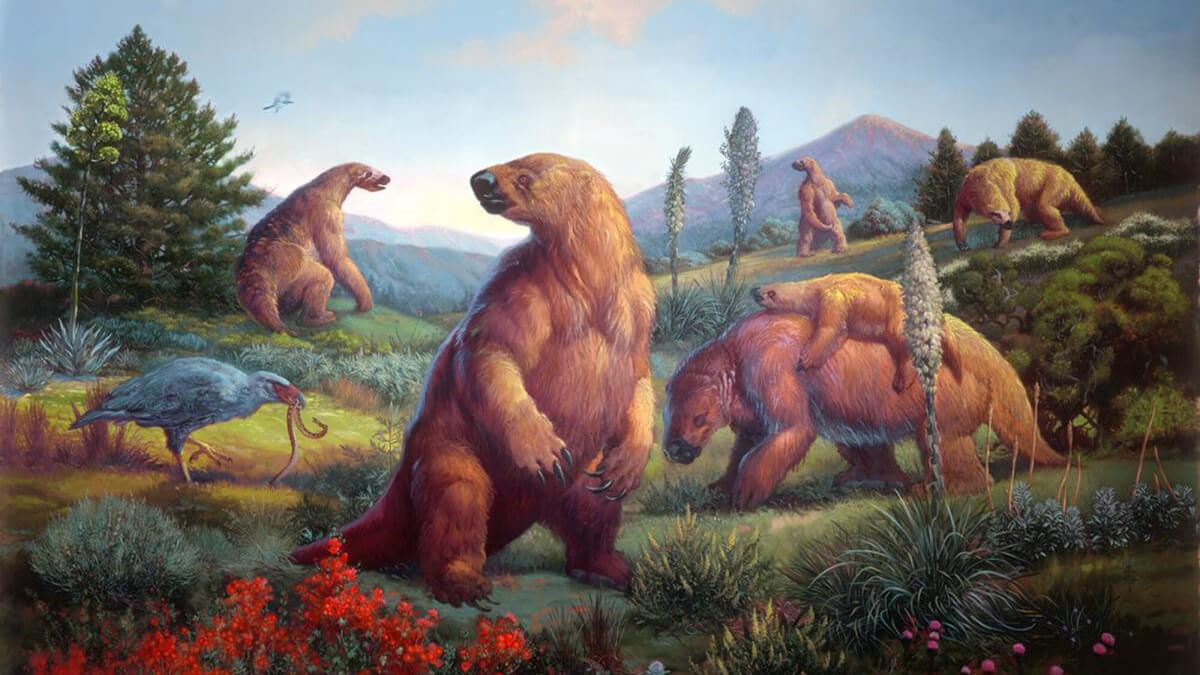
The megatherium was a giant sloth that measured up to 20 feet tall from head to tail and weighed almost 5 tons. It became extinct at the end of the Pleistocene (between 8 and 10 thousand years ago). It was herbivorous, but due to its large size, its behavior differed from that of today’s sloths, as it was a terrestrial specimen. However, it could stand up on its hind legs to access vegetation.
This mammal had few teeth in its mouth.
14. Megalodon (Otodus megalodon)

The megalodon is one of the most fascinating extinct prehistoric animals, given its exceptional size, which exceeded 52 feet in length, and its large teeth measuring up to 7 inches long. In addition, it had 270 teeth and a great bite amplitude and force.
It’s important to note that the estimates of its dimensions are based on a few fossil pieces found, mostly jaws and some vertebrae. Remember that it was a cartilaginous fish.
It lived during the Cenozoic, and the cause of its extinction isn’t known with certainty. However, there are different theories among scientists. A study published in Nature explains that it could have coexisted with the great white shark (Carcharodon carcharias) and that competition for resources was key in its disappearance.
Others think that changes in ocean temperature affected its metabolism, causing its extinction.
Living prehistoric animals
Now it’s time to talk about those prehistoric animals that remain alive thanks to their ability to adapt and survive. Among them, there are beings called panchronic organisms or living fossils that have changed little since their ancient origins. We also find some that were thought to have disappeared years ago. Let’s look at some examples, both vertebrates and invertebrates.
15. Nautilus (Nautilus pompilus)

Here we have another shelled cephalopod, the nautilus, which inhabits depths of up to 1640 feet. They’re approximately 8 inches long, and their spiral shell, divided into chambers, is brown and white in color. In addition, they have 90 small tentacles without suckers, eyes, and a fleshy hood that they use to protect their soft parts from predators.
Nautiluses originated about 400 million years ago. Today, living species inhabit the western Pacific and eastern Indian Ocean at depths of no more than 2300 feet.
16. Sea lily (Crinoidea)

In this case, we’re referring to a group of echinoderms that inhabit the sea, some in the depths and others occupying coral reefs. They usually have a body divided into two regions: A calyx or central portion and the rays, elongated arm-like structures used during feeding and locomotion.
They may also have a stalk to adhere to the substrate and other protuberances called cirri. Many extinct species of crinoids are known only from their fossils. Of these, a single lineage survived at the end of the Permian period.
17. Atlantic horseshoe crab (Limulus polyphemus)
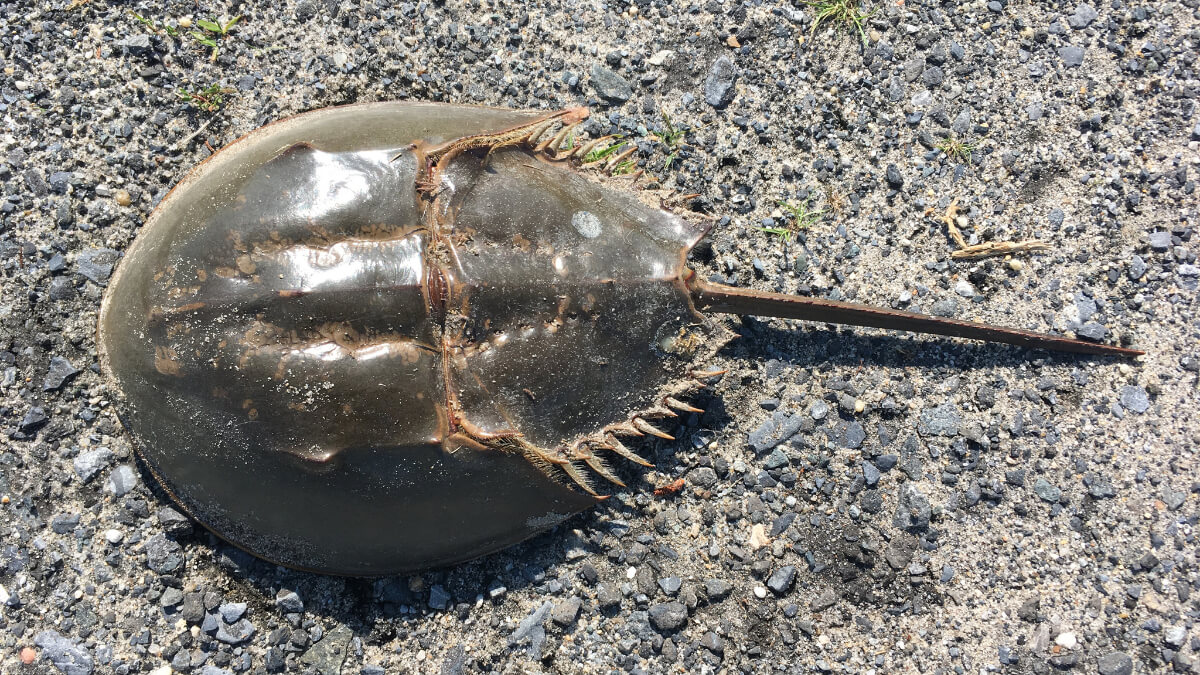
The Atlantic horseshoe crab is an arthropod whose ancestors date back some 500 million years to the Ordovician period. Today, it’s the only survivor of the genus Limulus, for which there’s a poor fossil record. It lives in shallow waters, on sandy or muddy bottoms, and feeds on worms, mollusks, and algae.
It’s also known as the American horseshoe crab. However, it’s not a crab, as it’s related to arachnids.
18. Tuatara (Sphenodon puntactus)
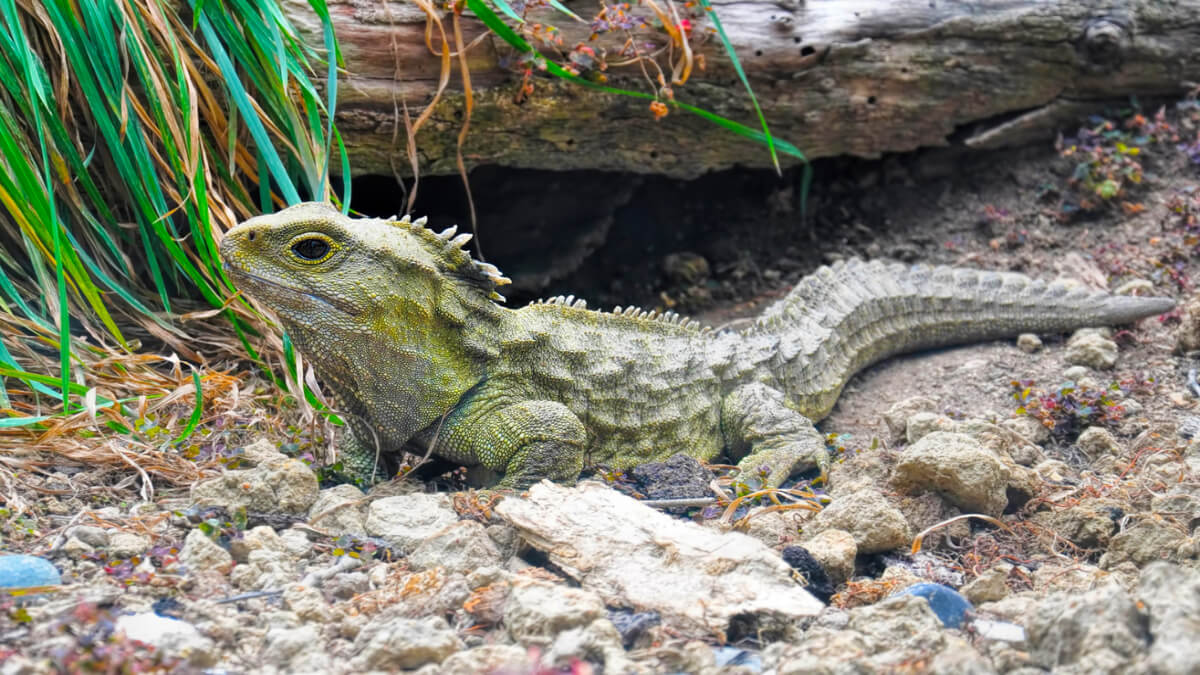
This is the only living representative of the rinocephalus group, ancient reptiles that appeared in the Triassic period and became extinct about 60 million years ago. They only inhabit New Zealand and are very similar to their ancestors, although they also have their own unique characteristics.
Males are usually larger, measuring approximately 24 inches in length, while females barely reach 15.75 inches. They stand out for their spiny crest and lack of external ears. In addition, they have a “third eye” or “parietal eye” located in the upper part of the skull, the function of which is unknown.
19. Coelacanth (Latimeria chalumnae)
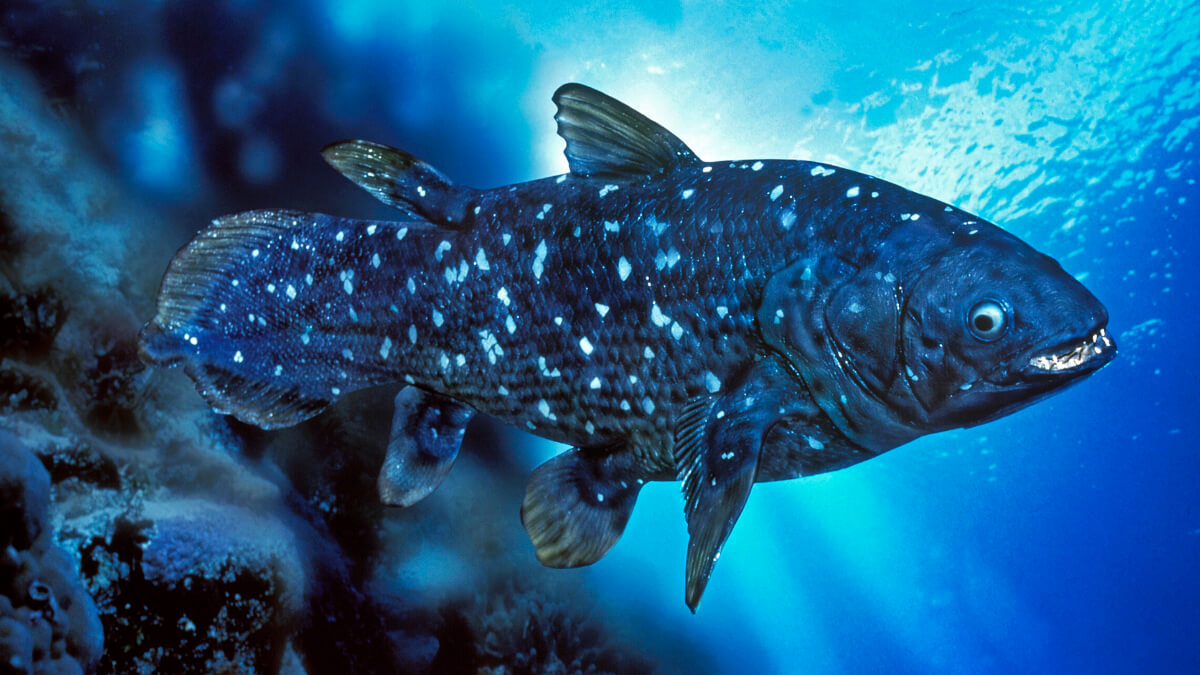
The lineage of these prehistoric animals has a fossil record from the Devonian to the Cretaceous periods, so they were thought to be extinct. However, in 1938, they were found in the waters of the Chalumna River in South Africa. They’re marine animals and live in caves with variable depths (between 755 and 7550 feet), based on the abundance of species and temperature.
They can measure up to 6.5 feet in length, and the female is larger than the male. The coelacanth has blue scales and a white spot. It also has seven fins with fleshy lobes. The pectoral and pelvic pairs can move synchronously, similar to a land animal with its four legs.
Its morphology has remained almost intact since hundreds of millions of years ago, making it a “living fossil of the seas.” It’s also thought that its lineage gave rise to the tetrapods. This is due to its particular characteristics.
To date, there are only two living species of coelacanths: L. chalumnae and L. menadoensis.
20. Neopilina (Neopilina galatheae)
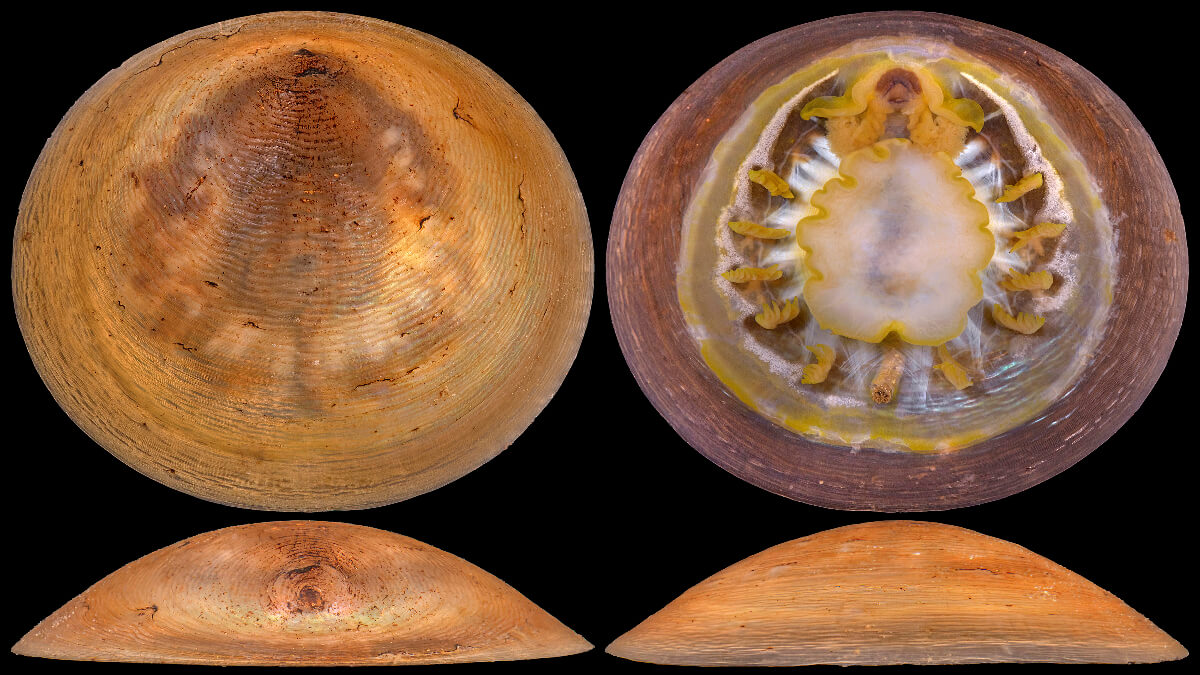
This invertebrate is a mollusk belonging to the Monoplacophora class. It’s small, marine, benthic, and has a shell with a single conical plate, which covers the soft body.
It comes from an ancient lineage. Until 1952, it was thought to be extinct, as it was only known from the Cambrian and Devonian fossil record. However, with the expedition of the ship Galathea, these organisms were dragged onto its deck. Therefore, in 1957, the description of this species was published.
The name Neopilina means “new Pilina.” This was another similar mollusk that lived about 400 million years ago.
A small part of the prehistoric fauna
We’ve come to the end of our list of twenty prehistoric animals, both extinct and alive, with invertebrate and vertebrate representatives. However, this list represents only a small part of the fauna that accompanied the planet in ancient times, although some species are still present today. Scientists continue discovering specimens and adding species. We invite you to continue learning about this world and its biodiversity.
Life on planet Earth began a long time ago. Although the exact date is unknown, the first fossils date back more than 3 billion years. Since that time, there have been many changes at the biological level, with extinct life forms and other lineages that still remain in time. Do you want to learn about some prehistoric animals?
When you hear the words “prehistoric animals”, dinosaurs are probably the first to come to mind, as they’re the most well-known example and even the protagonists of major film productions. Other well-known prehistoric animals are mammoths and saber-toothed dinosaurs. However, there are more impressive specimens that are well worth discovering. Let’s take a look at 20 specimens in the following list along with their main characteristics.
What are prehistoric animals?
Before we begin our tour of the prehistoric world, let’s clarify a bit what organisms we’re referring to. In this case, we’re talking about the animals that existed on the planet before historic recordings, that is, before the invention of writing.
Some coexisted with the first hominids and others didn’t share their habitat with man.
Today, many of these creatures are extinct. However, certain lineages with a greater capacity for adaptation and survival persist today, perhaps not in the exact form of antiquity but with few changes in their appearance.
Extinct prehistoric animals
Most of the animals that have ever existed are now extinct from the planet forever. The causes are diverse, including climatic conditions, competition for resources, and major catastrophes such as volcanic eruptions and asteroid impacts, among others. Below are some specimens and their characteristics.
1. Saber-toothed tiger (Smilodon)

One of the most popular prehistoric animals is the saber-toothed tiger, with its long tusks up to 10 inches long. It was approximately 3.75 feet tall. It also had short but strong legs, which were useful for hunting large prey.
In fact, there were three species of them, included in the genus Smilodon:
- S. gracilis: the smallest of the three, reaching up to 220 pounds in weight.
- S. fatalis: of intermediate size, similar to a Siberian tiger, with a mass of up to 615 pounds.
- S. populator: the largest, weighing between 485 and 800 pounds (larger than any feline today).
The saber-toothed tiger was a skilled hunter, biting its prey in the neck to cut important arteries and produce a quick death.
Its disappearance from the planet is thought to have been caused by climate change and the extinction of its prey. Because its diet was so specialized in large mammals, it was unable to adapt to smaller ones.
2. Woolly mammoth (Mammuthus primigenius)

Also called woolly elephant or tundra mammoth. It owes its name to its very thick and long coat of hair that covered its body. This hair was brownish in color, lighter on the inner part and darker on the outer mantle. In addition to this protective covering, it had skin that was up to 3 inches thick: A true thermal insulator.
The woolly mammoth also stands out for its large size and its peculiar tusks. It was between 10 and 12 feet tall and weighed between 6 and 8 tons. Global warming after the last ice age caused the loss of its habitat and its extinction.
3. Spiny dogfish (Acanthodii)

Spiny dogfish were small fish less than 10 inches in length, although some specimens, such as Gyracanthus, reached a size of approximately 6.5 feet. Some species lacked teeth, suggesting filter feeding, but others lived a predatory life.
They lived from the Silurian period to the Permian, when they became extinct. Moreover, this group is the subject of great debate, as some experts consider them the first bony fishes, while others point out that they’re more closely related to the first cartilaginous fishes.
They’re named for the presence of a large spine in front of each of their fins.
4. Tyrannosaurus (Tyrannosaurus rex)

One of the most well-known prehistoric animals is the famous T-rex or Tyrannosaurus rex, which inhabited North America 65 million years ago. Among its characteristics are the following:
- Long and muscular tail.
- Large size (about 39 feet long).
- Well-developed eyesight, sense of smell, hearing, and balance.
- Large skull (up to 5.3 feet), wide jaws, and teeth up to 6 inches long.
- Short neck, as well as arms and hands with double digits, and long and robust hind limbs.
There is much debate about its external appearance, as some scientists think it may have had feathers on its body. Another controversial aspect is its diet, whether it was a predator or also lived a scavenger life.
Also, we can’t fail to mention its great bite force, which is more powerful than that of the Nile crocodile. This specimen is one of the most famous dinosaurs in history.
5. Yutyrannus (Yutyrannus huali)

This is another large dinosaur and a relative of the tyrannosaurus. It’s known with certainty that it was a feathered animal. It inhabited Asia in the Cretaceous, in a cold forest environment.
The presence of feathers was very useful in regulating its body temperature.
It was almost 30 feet long and had a mass of 1.5 tons. Despite its long and filamentous feathers, its large size prevented it from flying; however, this covering was an important thermal insulation in its habitat.
6. Labocania (Labocania anomala)

This is a carnivore found in the fossiliferous formation of La Bocana Roja in Baja California, which is the reason for its name Labocania. The epithet “anomala” refers to the combination of physical characteristics similar to tyrannosaurs and other types of dinosaurs.
Little is known about this carnivore, but it’s estimated to be about 26 feet long and weigh 1.5 tons. It lived in the Cretaceous, about 75 million years ago.
7. Argentinosaurus (Argentinosaurus huinculensis)

We continue mentioning dinosaurs in our list of extinct prehistoric animals. In this case, we have a herbivore, the Argentinosaurus. There’s controversy as to its size, due to the lack of evidence. However, it’s estimated that its body was around 98 to 130 feet long and weighed between 50 and 100 tons. For this reason, it’s considered one of the largest land animals that ever existed.
It had a long and robust neck, a small head, and a thick tail. Its teeth were adapted to cut the leaves of trees, as it didn’t chew its food. Its stomach was responsible for processing all the vegetation.
The neck of Argentinosaurus allowed it to have access to the available vegetation. Therefore, it could count on all the food it needed to satisfy its large size.
8. Pteranodon

In this case, we’re referring to a genus of strong flying reptiles that lived in the Late Cretaceous period. They had a wingspan of about 23 feet or more, although their bodies were somewhat small in comparison to the size of their wings.
One striking aspect of their appearance was the presence of a crest on the skull, which projected upwards on the back of the head. The male had it larger than the female. In addition, it had long, toothless jaws, which it’s believed to have used to feed on fish.
9. Ammonite (Ammonoids)

Among the prehistoric animals, we also find invertebrates, such as cephalopods known as ammonites. These populated the seas for a long period, at depths of no more than 985 feet.
The first representatives of the group appeared around 400 million years ago, while the last specimens became extinct 65 million years ago.
These soft-bodied animals had a conical shell that was rolled up to greater or lesser degrees and divided into chambers. Today, this shell is a record of their existence on the planet. Their body is a mystery, but it’s believed that they may have had about ten slender arms.
Another outstanding feature of their body was their beak, which was usually composed of chitin, as in other cephalopods. Their diet was variable and included the following species:
- Fish
- Bivalves
- Crustaceans
- Sea lilies
- Foraminifera
- Other ammonites
Ammonites were a very successful group, thanks to their high reproductive rates and small size at birth (just a few millimeters). Therefore, they were part of the marine plankton at this stage of their life, floating in the ocean at the mercy of the currents. This aspect allowed their worldwide distribution.
10. Nectocaris pteryx

Here we have another cephalopod, which is considered the oldest because it dates back to about 500 million years ago, in the Cambrian period. The interesting thing about this animal was its small size, as it was only a few centimeters long. Its body was soft, flattened, and rhomboidal in shape. It lacked a shell and had a pair of long, prehensile tentacles.
El Nectocaris pteryx had a pair of wide lateral fins on its body, one on each side, and a siphon that served as a propeller. It also had a pair of eyes. It’s believed to have been a carnivore or scavenger.
11. Trilobite

Now it’s time to talk about other invertebrates. Specifically, a group of marine and benthic arthropods, i.e., bottom-dwellers of the ocean floor. They appeared during the Cambrian period, and some species lived until the Permian. They had a variable size and a body with three lobes, a characteristic to which they owe their name.
They also had a segmented body divided into three regions: a cephalic section, the cephalon; an intermediate section, the thorax; and a posterior or caudal section, the pygidium. Each possessed a pair of articulated appendages. Some were blind, but others had eyes.
Trilobites had a chitinous exoskeleton, like any arthropod.
12. Yanliaomyzon lamprey (Yanliaomyzon occisor)

Sea lampreys are ancient animals that existed more than 360 million years ago. However, the species Yanliaomyzon occasion was found in rocks about 160 million years old in China. It possessed a staggering size of 25 inches, which positions it as the largest fossil lamprey yet found, as the more remote ones were smaller.
It had an oral sucker full of sharp teeth, which allowed it a carnivorous diet, and it fed on chunks of meat in bites. In addition, it’s believed to have been an active swimmer that went after its prey. This is detailed in a publication in the journal Nature Communications.
Occisor means killer, so the name refers to the specimen’s hunting ability.
Many species of lamprey are still alive today, and certain aspects of their morphology have been preserved over time. However, this feeding apparatus, similar to that of some modern species, differs from the original pattern of older specimens. Thanks to their discovery, more is known about their evolutionary development.
13. Megatherium (Megatherium americanum)

The megatherium was a giant sloth that measured up to 20 feet tall from head to tail and weighed almost 5 tons. It became extinct at the end of the Pleistocene (between 8 and 10 thousand years ago). It was herbivorous, but due to its large size, its behavior differed from that of today’s sloths, as it was a terrestrial specimen. However, it could stand up on its hind legs to access vegetation.
This mammal had few teeth in its mouth.
14. Megalodon (Otodus megalodon)

The megalodon is one of the most fascinating extinct prehistoric animals, given its exceptional size, which exceeded 52 feet in length, and its large teeth measuring up to 7 inches long. In addition, it had 270 teeth and a great bite amplitude and force.
It’s important to note that the estimates of its dimensions are based on a few fossil pieces found, mostly jaws and some vertebrae. Remember that it was a cartilaginous fish.
It lived during the Cenozoic, and the cause of its extinction isn’t known with certainty. However, there are different theories among scientists. A study published in Nature explains that it could have coexisted with the great white shark (Carcharodon carcharias) and that competition for resources was key in its disappearance.
Others think that changes in ocean temperature affected its metabolism, causing its extinction.
Living prehistoric animals
Now it’s time to talk about those prehistoric animals that remain alive thanks to their ability to adapt and survive. Among them, there are beings called panchronic organisms or living fossils that have changed little since their ancient origins. We also find some that were thought to have disappeared years ago. Let’s look at some examples, both vertebrates and invertebrates.
15. Nautilus (Nautilus pompilus)

Here we have another shelled cephalopod, the nautilus, which inhabits depths of up to 1640 feet. They’re approximately 8 inches long, and their spiral shell, divided into chambers, is brown and white in color. In addition, they have 90 small tentacles without suckers, eyes, and a fleshy hood that they use to protect their soft parts from predators.
Nautiluses originated about 400 million years ago. Today, living species inhabit the western Pacific and eastern Indian Ocean at depths of no more than 2300 feet.
16. Sea lily (Crinoidea)

In this case, we’re referring to a group of echinoderms that inhabit the sea, some in the depths and others occupying coral reefs. They usually have a body divided into two regions: A calyx or central portion and the rays, elongated arm-like structures used during feeding and locomotion.
They may also have a stalk to adhere to the substrate and other protuberances called cirri. Many extinct species of crinoids are known only from their fossils. Of these, a single lineage survived at the end of the Permian period.
17. Atlantic horseshoe crab (Limulus polyphemus)

The Atlantic horseshoe crab is an arthropod whose ancestors date back some 500 million years to the Ordovician period. Today, it’s the only survivor of the genus Limulus, for which there’s a poor fossil record. It lives in shallow waters, on sandy or muddy bottoms, and feeds on worms, mollusks, and algae.
It’s also known as the American horseshoe crab. However, it’s not a crab, as it’s related to arachnids.
18. Tuatara (Sphenodon puntactus)

This is the only living representative of the rinocephalus group, ancient reptiles that appeared in the Triassic period and became extinct about 60 million years ago. They only inhabit New Zealand and are very similar to their ancestors, although they also have their own unique characteristics.
Males are usually larger, measuring approximately 24 inches in length, while females barely reach 15.75 inches. They stand out for their spiny crest and lack of external ears. In addition, they have a “third eye” or “parietal eye” located in the upper part of the skull, the function of which is unknown.
19. Coelacanth (Latimeria chalumnae)

The lineage of these prehistoric animals has a fossil record from the Devonian to the Cretaceous periods, so they were thought to be extinct. However, in 1938, they were found in the waters of the Chalumna River in South Africa. They’re marine animals and live in caves with variable depths (between 755 and 7550 feet), based on the abundance of species and temperature.
They can measure up to 6.5 feet in length, and the female is larger than the male. The coelacanth has blue scales and a white spot. It also has seven fins with fleshy lobes. The pectoral and pelvic pairs can move synchronously, similar to a land animal with its four legs.
Its morphology has remained almost intact since hundreds of millions of years ago, making it a “living fossil of the seas.” It’s also thought that its lineage gave rise to the tetrapods. This is due to its particular characteristics.
To date, there are only two living species of coelacanths: L. chalumnae and L. menadoensis.
20. Neopilina (Neopilina galatheae)

This invertebrate is a mollusk belonging to the Monoplacophora class. It’s small, marine, benthic, and has a shell with a single conical plate, which covers the soft body.
It comes from an ancient lineage. Until 1952, it was thought to be extinct, as it was only known from the Cambrian and Devonian fossil record. However, with the expedition of the ship Galathea, these organisms were dragged onto its deck. Therefore, in 1957, the description of this species was published.
The name Neopilina means “new Pilina.” This was another similar mollusk that lived about 400 million years ago.
A small part of the prehistoric fauna
We’ve come to the end of our list of twenty prehistoric animals, both extinct and alive, with invertebrate and vertebrate representatives. However, this list represents only a small part of the fauna that accompanied the planet in ancient times, although some species are still present today. Scientists continue discovering specimens and adding species. We invite you to continue learning about this world and its biodiversity.
All cited sources were thoroughly reviewed by our team to ensure their quality, reliability, currency, and validity. The bibliography of this article was considered reliable and of academic or scientific accuracy.
- CONABIO. (2024). Dientes de Sable. Cosultado el 24 de enero de 2024. https://www.biodiversidad.gob.mx/biodiversidad/EdHielo/dientesSable
- Datta, S. (2010). Neopilina galatheae: living fossil from the ocean. Science Report, 55.
https://nopr.niscpr.res.in/bitstream/123456789/10594/1/SR%2047%2811%29%20%28Living%20Fossile%29.pdf - Enciclopedia Británica. (2024). Spiny shark. Consultado el 24 de enero de 2024. https://www.britannica.com/animal/spiny-shark
- Enciclopedia Británica. (2024). Trilobite. Consultado el 24 de enero de 2023. https://www.britannica.com/animal/trilobite
- Enciclopedia Británica. (2024). Pteranodon. Consultado el 24 de enero de 2024. https://www.britannica.com/animal/Pteranodon
- Enciclopedia Británica. (2024). Woolly mammoth. Consultado el 24 de enero de 2024. https://www.britannica.com/animal/woolly-mammoth
- Fierro, H., Gómez, C., Gío, R., & Buitrón, B. (2004). Los que se niegan a desaparecer. Ciencia, 17-23. https://www.revistaciencia.amc.edu.mx/images/revista/55_1/niegan_desaparecer.pdf
- García, P. (2020). Amonites, ¿qué nos cuentas sus conchas? Naturalmente. Museo de Ciencias Naturales, 29-34. https://www.mncn.csic.es/es/Comunicaci%C3%B3n/amonites-que-nos-cuentan-sus-conchas
- Goetz, B. (2000). Nautilus pompilius. Animal Diversity Web. Consultado el 24 de enero de 2024. https://animaldiversity.org/accounts/Nautilus_pompilius/
- Herrera, P. (2023). Megalodon: el gigante prehistórico de los mares. UNAM. Consultado el 24 de enero de 2024. https://unamglobal.unam.mx/global_revista/megalodon-el-gigante-prehistorico-de-los-mares/
- Kellogg, D., & Fautin, D. (2001). Crinoidea. Animal Diversity Web. Consultado el 24 de enero de 2024. https://animaldiversity.org/accounts/Crinoidea/
- Luna, C. (2015). Los lagartos tiranos que gobernaron México. Revista Digital Universitaria UNAM, 16(11), 1-16. https://www.revista.unam.mx/vol.16/num11/art88/
- Martínez, C. (2018). El perezoso gigante que fascinó al mundo. Museo de Ciencias Naturales. Consultado el 24 de enero de 2024. https://www.mncn.csic.es/es/comunicacion/blog/el-perezoso-gigante-que-fascino-al-mundo
- McCormack, J., Griffiths, M., Kim, S., Shimada, K., Karnes, M., Maiscj, H., Pedeszani, S., Bourgon, N., Jaouen, K., Becker, M., Jöns, N., Sisma-Ventura, G., Straube, N., Pollerspöck, J., Hublin, J., Eagle, R., & Tütken, T. (2022). Trophic position of Otodus megalodon and great white sharks through time revealed by zinc isotopes. Nature Communication, 13, 2980. https://www.nature.com/articles/s41467-022-30528-9
- Museo Virtual de Paleontología. (2015). Trilobites. Universidad de Huelva. Consultado el 24 de enero de 2023. https://www.uhu.es/museovirtualpaleontologia/galerias/invertebrados/trilobites.html
- Musico, B. (1999). Sphenodon puntactus. Animal Diversity Web. Consultado el 24 de enero de 2024. https://animaldiversity.org/accounts/Sphenodon_punctatus/
- Smith, M., & Caron, JB. (2010). Primitive soft-bodied cephalopods from the Cambrian. Nature, 465, 469–472. https://www.nature.com/articles/nature09068
- Wu, F., Janvier, P. & Zhang, C. (2023). The rise of predation in Jurassic lampreys. Nature Communications, 14, 6652. https://www.nature.com/articles/s41467-023-42251-0
This text is provided for informational purposes only and does not replace consultation with a professional. If in doubt, consult your specialist.








